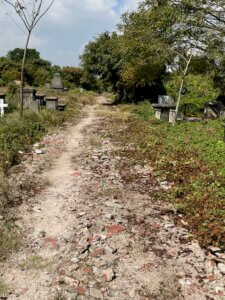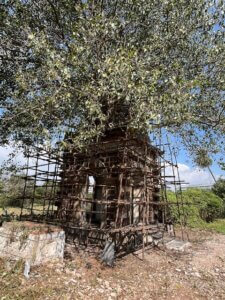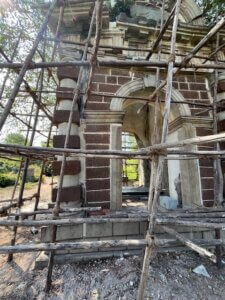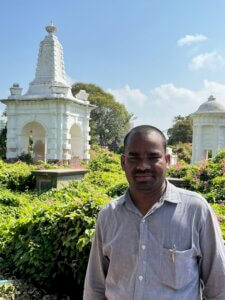BACSA member Andrew Whitehead recently re-visited St Mary’s Burial Ground, Chennai, where BACSA is currently supporting conservation work. Here he describes recent changes and the work in progress.
The cemetery is difficult to locate, with virtually no signage, so Andrew has posted a short YouTube video to help prospective visitors. He has also posted an account of his visit on his personal blog, which is available here.
On the morning of 28th February 2024, I visited the St Mary’s Anglican / Church of South India burial ground in the Island district of Chennai, where BACSA is supporting conservation work. This was not the first Anglican cemetery in what was Madras. It opened in the 1760s, was somewhat superseded when St George’s Cathedral was built in 1817, and was only used sparingly after the close of the 19th century. I believe the burial ground remains under the jurisdiction of the 17th century St Mary’s church in the Fort area, which is part of the Church of South India.

Photo: AW, 28 Feb 2024
This was my third or fourth visit to this burial ground. Part of its charm is the sense of wilderness, and the gradual decay of grandiose Raj-era graves and memorials. It remains an utterly magical place. This is perhaps – after Park Street in Calcutta – the most important European cemetery in India and its historical resonance is immense.
The grounds are in slightly better condition, and are more easily navigable, than on my previous visits – though the overall improvement is perhaps modest. The two Commonwealth War Grave compounds – broadly one WW1 and the other WW2 – are, as ever, impeccably maintained, though they are at the far end of the burial ground and not easy to find.
The main gate is generally kept padlocked shut; pedestrian access is through a small iron gate on the left hand side.
The contractors have renewed the tiling of one of the two small porches by the entrance to the burial ground. That looks to be in good order.
I spent forty minutes walking round this very substantial burial ground with Sravani Naraparaju, a qualified architect and conservator employed by the contractors undertaking the conservation work, which has been going on for about eight months. She introduced me to the site supervisor, Anil Mahto, who was in charge of four workers clearing parts of the main path and immediate surrounds.
The current work on the burial ground has two main areas of activity:
• Improving the main path through the site
• Conserving the Anderson memorial, which lies just off the main path.
CEMETERY PATHS

Photo: AW, 28 Feb 2024

Photo: AW, 28 Feb 2024
The main path is a broad path which has now largely been cleared of undergrowth, in preparation for the laying of laterite stones to make it more easily navigable.
These substantial stones will be laid in such a way as to allow a little vegetation to grow between the stones, so the path will (I believe) have a ‘natural’ feel while being much easier to use and maintain.
There are two other substantial paths in the cemetery: one is on the right as you enter past some fairly new graves (there are still occasional interments), and has a tarmac-style surface which long predates the current work; the other quite narrow, but accessible, is a fork off to the left, which leads to the two compounds of Commonwealth war graves.
ANDERSON MEMORIAL

Photo: AW, 28 Feb 2024
This is a commanding memorial to the botanist and medical expert James Anderson (1738-1809), a particular focus of the conservation work and a considerable challenge. There is simple bamboo scaffolding around the memorial.
The handful of steps up to the memorial slab have been remade; pointing work has been undertaken on the exterior; and a lime screen has been applied to the interior. To my lay eye, this work seems to have been done well.
The memorial slab is badly cracked, and the contractors are planning to make good those cracks without obscuring or removing any of the original granite and inscription.

has been repointed
Photo: AW, 28 Feb 2024

been replaced
Photo: AW, 28 Feb 2024

screen applied to the interior
Photo: AW, 28 Feb 2024

cracked
Photo: AW, 28 Feb 2024

Photo: AW, 28 Feb 2024
The big challenge is the tree and shrubs which are now growing out of the upper part of the memorial and are so wound round some of the lower part as to be, in essence, integral to the structure as it now is.
The decision has been made not to try to remove the tree, partly because the moulding of living and dead is itself elegiac, and partly because it will be enormously difficult and perhaps structurally hazardous to remove the twisting trunks and similar.
But this leads to further problems. Around the memorial, on the ground, there are substantial pieces of masonry that have become detached – these cannot be put back in place because of the tree and shrubs.
Consideration is being given to putting a glass canopy on top of the memorial, particularly to prevent damage caused by rainwater seepage, but it’s not at all clear how that will be possible given the vegetation.
My warm thanks to BACSA’s Denise Love for her kindness and persistence in making my visit possible, and to Sravani Naraparaju for sparing the time to show me round – and for the professional care and concern she is so clearly bringing to this project.

Conservator
Photo: AW, 28 Feb 2024

Site Supervisor
Photo: AW, 28 Feb 2024
THE FUTURE
Sravani told me that while she has seen a very small number of visitors to the war graves plots, the rest of the burial ground gets no visitors at all.
That is a real shame, and I hope it may be possible in due course to rectify this. Heritage walks are now a big thing in Chennai – more for history-conscious residents than for tourists – and it would be wonderful if organisations such as Chennai Past Forward and Madras Inherited could be encouraged and supported in devising and organising walks here, subject to the blessing of the church.
Andrew Whitehead
